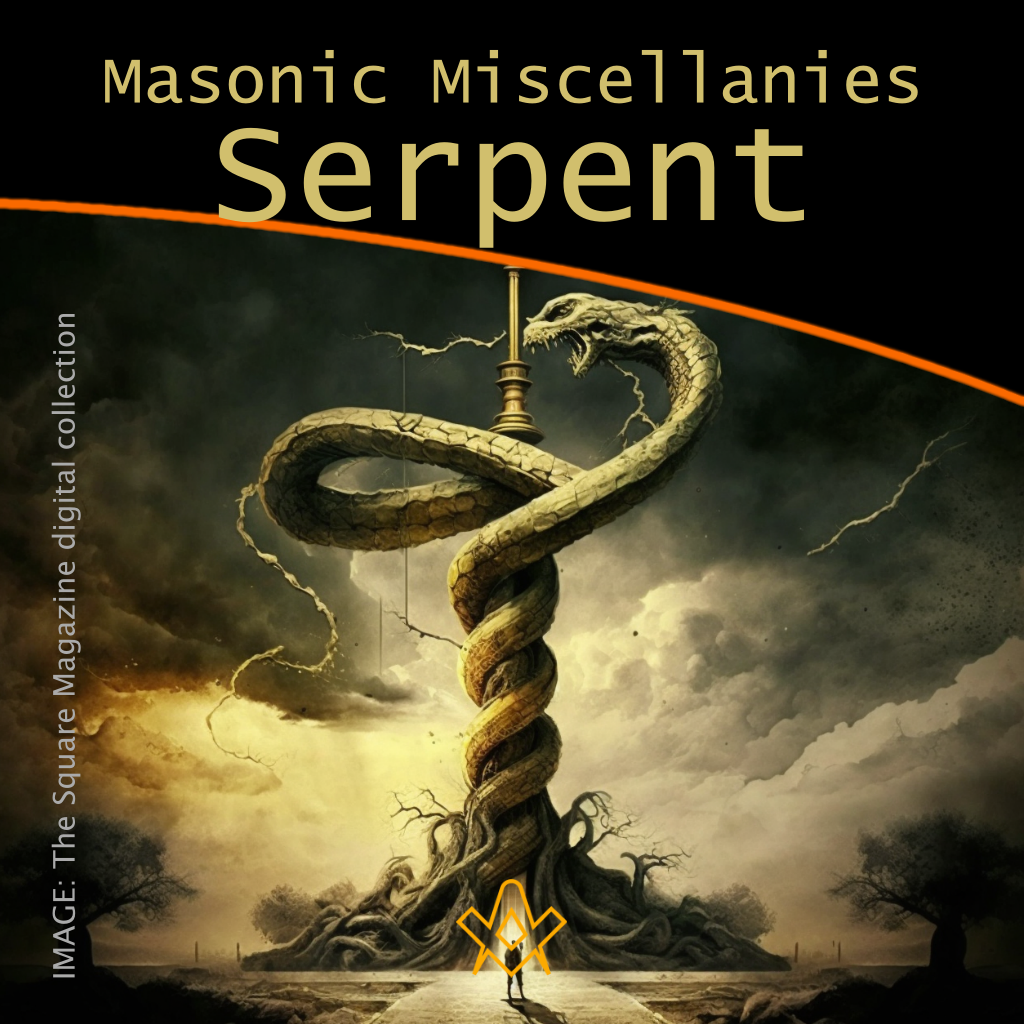As a symbol, the serpent obtained a prominent place in all the ancient initiations and religions.
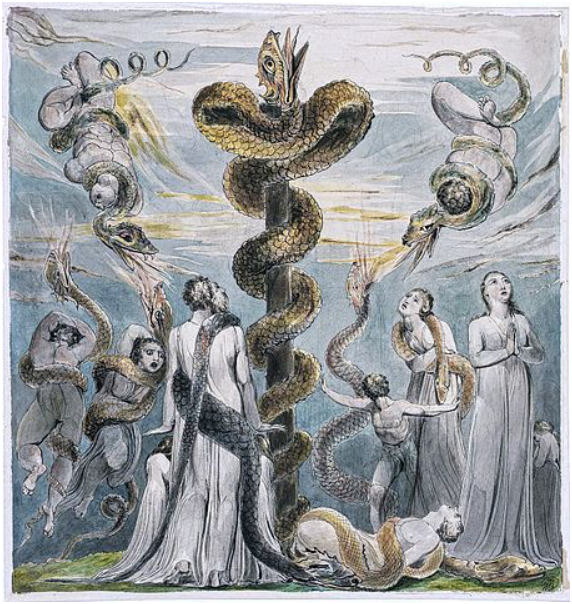
The brass serpent (Nehushtan) constructed by Moses and set on a pole so that “if a serpent had bitten any man, when he beheld the serpent of brass he lived” (Numbers 21:9). Painting by William Blake.
IMAGE LINKED: wikimedia Attribution 4.0 International (CC BY 4.0)
Among the Egyptians it was the symbol of Divine Wisdom when extended at length, and the serpent with his tail in his mouth was an emblem of eternity.
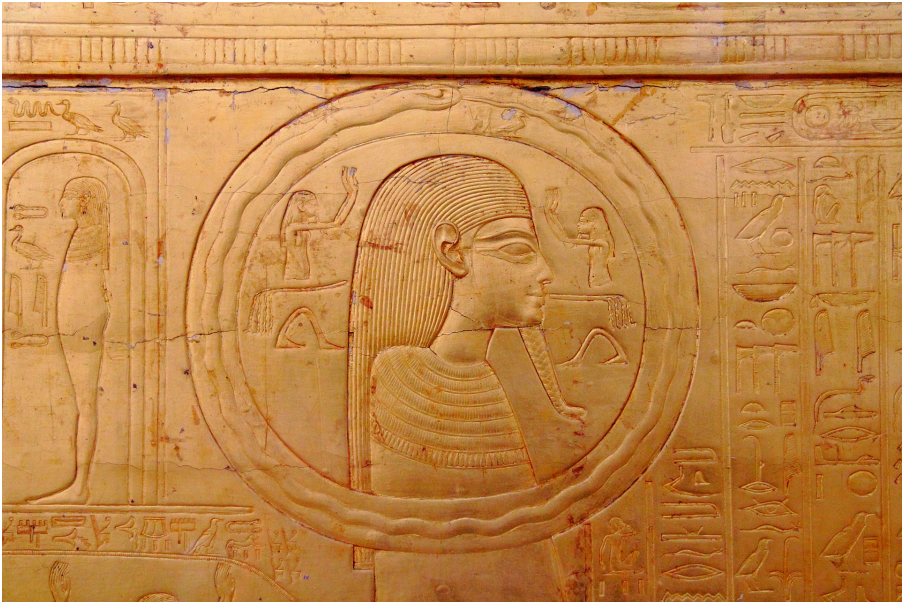
Ancient Egyptian Serpent – symbol of eternity. By Djehouty – Own work,
IMAGE LINKED: wikimedia Attribution 4.0 International (CC BY 4.0)
The winged globe and serpent symbolized their triune deity. In the ritual of Zoroaster, the serpent was a symbol of the universe.
In China, the ring between two serpents was the symbol of the world governed by the power and wisdom of the Creator. The same device is several times repeated on the Isiac table.
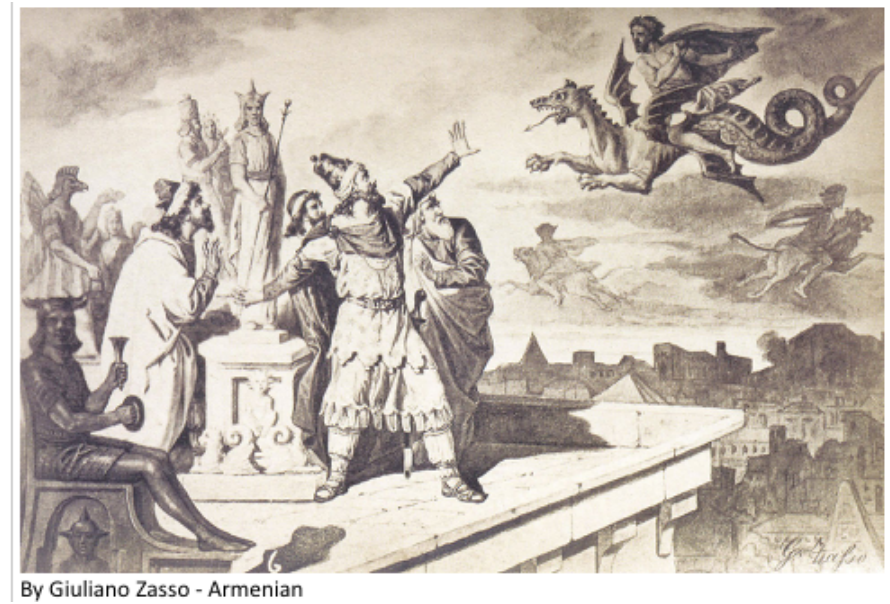
By Giuliano Zasso – Armenian History in Italian Art – Հայոց Պատմության Էջեր,
IMAGE LINKED: wikimedia Attribution 4.0 International (CC BY 4.0)
Higgins (Anacol. i, 521) says that, from the faculty which the serpent possessed of renewing itself, without the process of generation as to outward appearance, by annually casting its skin, it became like the Phoenix, the emblem of eternity; but he denies that it ever represented, even in Genesis, the evil principle.
Faber’s theory of the symbolism of the serpent, as set forth in his work on the Origin of Pagan Idolatry is ingenious.
He says that the ancients in part derived their idea of the serpent from the first tempter, and hence it was a hieroglyphic of the evil principle.
But as the deluge was thought to have emanated from the evil principle, the serpent became a symbol of the deluge.
He also represented the good principle; the idea being borrowed from the winged Seraphim which was blended with the Cherubim who guarded the tree of life — the Seraphim and Cherubim being sometimes considered as identical; and besides, in Hebrew, means both a seraph and a serpent.
But as the good principle was always male and female, the male serpent represented the Great Father, Adam or Noah, and the female serpent represented the ark or world, the microcosm and the macrocosm.
Hence the serpent represented the perpetually renovated world, and as such was used in all the mysteries.
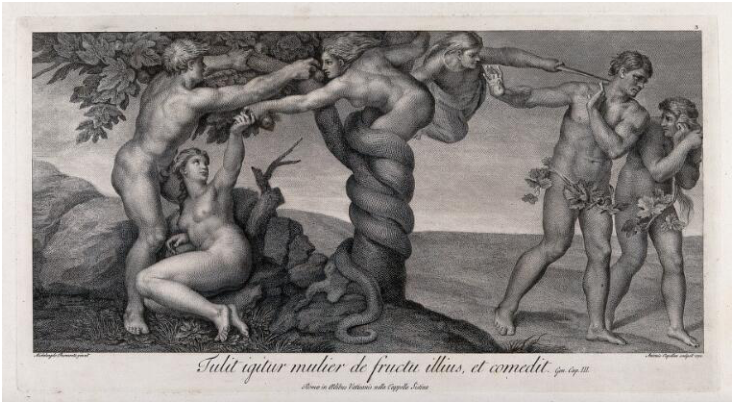
Eve receives the forbidden fruit from a serpent in the shape of a woman; the angel expels Adam and Eve from paradise. Engraving by A. Capellan, 1772, after Michelangelo.
IMAGE LINKED: wikimedia Attribution 4.0 International (CC BY 4.0)
Dr. Oliver brings his peculiar views to the interpretation, and says that in Christian Masonry the serpent is an emblem of the fall and the subsequent redemption of man.
In Ancient Craft Masonry, however, the serpent does not occur as a symbol.
In the Templar and in the Philosophic degrees— such as the Knight of the Brazen Serpent, where the serpent is combined with the cross — it is evidently a symbol of Christ; and thus the symbolism of these degrees is t closely connected with that of the Rose Croix.
The Serpent and Cross
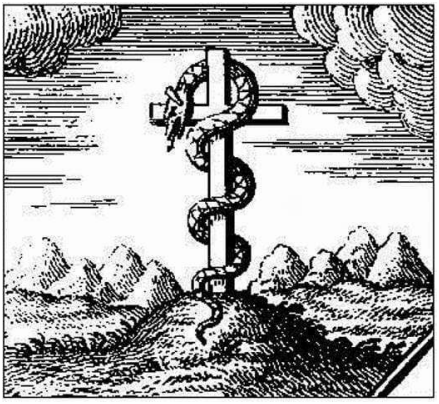
A symbol used in the degrees of Knights Templar and Knight of the Brazen Serpent. The cross is a tau cross T, and the serpent is twined around.
Its origin is found in Numbers xxi. 9. where it is said, “Moses made a serpent of brass, and put it upon a pole.
The Hebrew word Nes, here translated “a pole,” literally means a standard, or something elevated on high as a signal, and may be represented by a cross as well as by a pole.
Indeed, Justin Martyr calls it a cross.
Knight of the Brazen Serpent
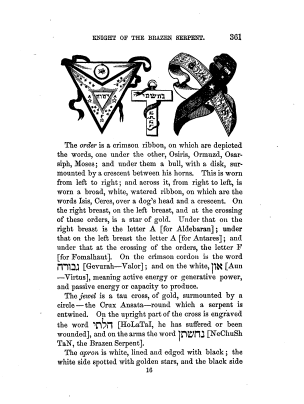
’25th Degree: Knight of The Brazen Serpent’, page 361, ‘The Book of the Ancient & Accepted Scottish Rite of Freemasonry’ (1884), Charles T. McClenechan.
IMAGE LINKED: wikimedia Attribution 4.0 International (CC BY 4.0)
The French name is Chevalier du Serpent d’ Airain.
The Twenty-fifth Degree of the Ancient and Accepted Scottish Rite. The history of this degree is founded upon the circumstances related in Numbers ch. xxi. ver. 6-9:
“And the Lord sent fiery serpents among the people, and they bit the people; and much people of Israel died.
Therefore the people came to Moses, and said, We have sinned; for we have spoken against the Lord, and against thee: pray unto the Lord that he take away the serpents from us.
And Moses prayed for the people. And the Lord said unto Moses, Make thee a fiery serpent, and set it upon a pole: and it shall come to pass, that every one that is bitten, when he looketh upon it shall live.
And Moses made a serpent of brass, and put it upon a pole; and it came to pass, that if a serpent had bitten any man, when he beheld the serpent of brass, he lived.”
In the old instructions the Lodge was called the Court of Sinai; the presiding officer was styled Most Puissant Grand Master, and represented Moses; while the two Wardens, or Ministers, represented Aaron and Joshua.
The Orator was called Pontiff; the Secretary, Grand Graver; and the candidate, a Traveler. In the modern ceremonial adopted in the United States, the Council represents the camp of the Israelites.
The first three officers represent Moses, Joshua, and Caleb, and are respectively styled Most Puissant Leader, Valiant Captain of the Host, and Illustrious Chief of the Ten Tribes.
The Orator represents Eleazar: the Secretary, Ithamar; the Treasurer, Phinehas; and the candidate an Intercessor for the people.
The jewel is a crux ansata, with a serpent entwined around it. On the upright of the cross is engraved the Hebrew word, khalati, meaning I have suffered, and on the arms, nakhushtan, a serpent.
The French ritualists would have done better to have substituted for the first word, khatati, I have sinned; the original in Numbers being, kathanu, we have sinned.
The apron is white, lined with black, and symbolically decorated.
There is an old legend which says that this Degree was founded in the time of the Crusades, by John Ralph, who established the Order in the Holy Land as a military and monastic society, and gave it the name of the Brazen Serpent, because it was a part of their obligation to receive and gratuitously nurse sick travelers, to protect them against the attacks of the Saracens, and escort them safely to Palestine; thus alluding to the healing and saving virtues of the Brazen Serpent among the Israelites in the wilderness.
Text source: Mackey’s Revised Encyclopedia of Freemasonry, vol. 2, 1929
Cagliostro’s Serpent Seal
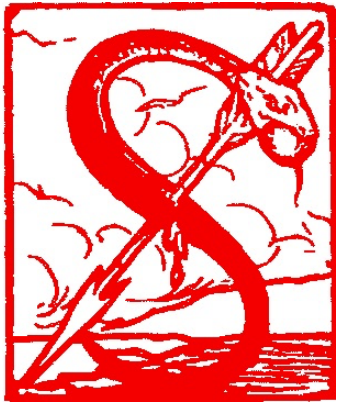
Count Alessandro di Cagliostro, an 18th century Italian alchemist and Freemason used a serpent pierced by an arrow as his personal seal.
Nineteenth century occult writer Eliphas Levi has this to say regarding this emblem:
As explained by the cabalistic letters of the names Acharat and Althotas, it expresses the chief characteristics of the Great Arcanum and the Great Work.
It is a serpent pierced by an arrow, thus representing the letter Aleph, an image of the union between active and passive, spirit and life, will and light.
The arrow is that of the antique Apollo, while the serpent is the python of fable, the green dragon of Hermetic philosophy.
The letter Aleph represents equilibrated unity. This pantacle is reproduced under various forms in the talismans of old magic. . . .
The arrow signifies the active principle, will, magical action, the coagulation of the dissolvent, the fixation of the volatile by projection and the penetration of earth by fire.
The union of the two is the universal balance, the Great Arcanum, the Great Work, the equilibrium of Jachin and Boaz.
The initials L.P.D., which accompany this figure, signify Liberty, Power, Duty, and also Light, Proportion, Density; Law, Principle and Right.
The Freemasons have changed the order of these initials, and in the form of L.’.D.’.P.: . they render them as Liberte de Penser, Liberty of Thought, inscribing these on a symbolical bridge, but for those who are not initiated they substitute Liberte de Passer, Liberty of Passage.
In the records of the prosecution of Cagliostro it is said that his examination elicited another meaning as follows: Lilia destrue pedibus: Trample the lilies under foot; and in support of this version may be cited a Masonic medal of the sixteenth or seventeenth century, depicting a branch of lilies severed by sword, having these words on the exergue: Talem dabit ultio messem – Revenge shall give this harvest.
Article by: Albert G. Mackey
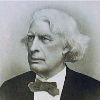
Albert Gallatin Mackey (1807 – 1881) was an American medical doctor and author.
He is best known for his books and articles about freemasonry, particularly the Masonic Landmarks.
In 1849 he established The Southern and Western Masonic Miscellany, a weekly masonic magazine.
He served as Grand Lecturer and Grand Secretary of The Grand Lodge of South Carolina, as well as Secretary General of the Supreme Council of the Ancient and Accepted Scottish Rite for the Southern Jurisdiction of the United States
Recent Articles: Masonic Miscellanies
 Masonic Miscellanies - Masonic Orb Discover the fascinating world of Masonic ball watch fobs, intricately crafted with tiny pyramids that form a cross when opened. These decorative accessories were all the rage in the late 1800s and early 1900s, and they still hold a certain allure today. Explore the different varieties and symbols found on these unique pieces that carry deep Masonic meaning. |
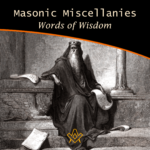 Masonic Miscellanies – Words of Wisdom Uncover timeless wisdom from King Solomon to Albert Pike in our latest Masonic Miscellanies, a treasure trove of insights for Masons. Journey through the ages and glean inspiring sayings, reflecting on their profound influence on Masonic principles. An enriching read for the enlightened. |
 Masonic Miscellanies - Symbolism of the Right Hand Unlock the enigmatic realm of Freemasonry as we delve into its age-old symbols, rituals, and philosophies. This thought-provoking exploration, drawn from Mackey's Revised Encyclopedia of Freemasonry, focuses on the iconic 'right hand' symbol - its rich history, universality, and profound significance. |
 Masonic Miscellanies - Order of the Secret Monitor Unveil the mystery of Freemasonry with 'The Order of the Secret Monitor'. Discover this lesser-known appendant order, its unique rituals, and the profound teachings it offers. Explore the bonds of friendship and brotherhood it fosters, all wrapped in an intriguing cloak of mystery. Your journey into the depths of Masonic wisdom begins here. |
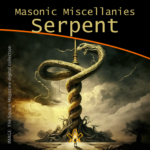 Masonic Miscellanies - The Symbol of the Serpent As a symbol, the serpent obtained a prominent place in all the ancient initiations and religions. |
 Masonic Miscellanies - The Four Veils in Royal Arch Masonry What are the four veils in Royal Arch Masonry? And what is the 'Ceremony of Passing the Veils'? Although common throughout Scotland, Ireland and the United States, it is mostly unknown in England, presently only worked in the Province of Bristol. ( and by dispensation ) |
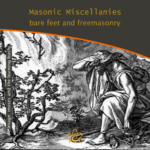 Masonic Miscellanies - Bare feet and Freemasonry A candidate for initiation into a Masonic Lodge often finds the requirements which he/she must fulfil somewhat odd. The mode of preparation often remains a puzzle, since the ritualistic explanation is not offered in full. Why are we 'slipshod' or "bare-footed" in Masonic Ritual? |
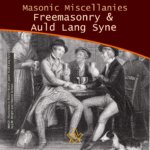 Masonic Miscellanies – Freemasonry and Auld Lang Syne Millions of people throughout the world will sing Auld Lang Syne to see out the Old Year. Few will know all the words, fewer still know what they mean, or that there is a link to Freemasonry. |
 Masonic Miscellanies - The Mosaic Pavement - why mosaic, why pavement? We are all familiar with the black and white chequered flooring of the Masonic lodge but where did it originate? There are a few theories… |
 Masonic Miscellanies – Masonic Master's Carpets Have you got a magic "Masonic Master's Carpet" in your lodge? I say 'magic' with my tongue firmly in my cheek because (as far as I know) these fabulous works of art don't bestow any mystical powers but can bestow some educational ones! However, considering their possible value today, they may magic up some interest (or funds). |
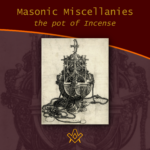 Masonic Miscellanies – The Pot of Incense Just when the pot of incense became an emblem of the third section of the Sublime Degree can not be stated with certainty. It is, apparently, an American invention or addition. But what does it symbolise? |
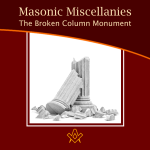 Masonic Miscellanies - The Broken Column Monument The story of the broken column was first illustrated by Amos Doolittle in the "True Masonic Chart" by Jeremy Cross, published in 1819. |
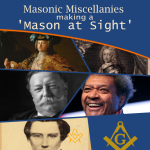 Masonic Miscellanies - Making a 'Mason at Sight' What does it mean to make a 'Mason at sight', and who was made one? |
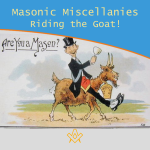 Masonic Miscellanies - Riding the Goat! Many Freemasons will have come across the phrase 'riding the goat', and will no doubt have been the butt of a joke about it (sorry, I couldn't resist!) But what does it mean and where did the phrase come from? |
 Masonic Miscellanies - What are the 'three dots'? Three dots or points in an upright triangular shape ∴ is most commonly known as the 'therefore' sign – so why is it used in Freemasonry? |
 Masonic Miscellanies - Keep Within Compass This month we discover a series of allegorical prints warning us to "Keep within Compass and you shall be sure, to avoid many troubles which others endure." |
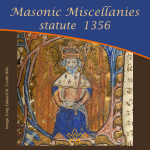 Masonic Miscellanies - statute 1356 Further to the reference in the article – The Builders - 6 - Free-Masons 'a statute was enacted against the Free-masons in 1356' – Regulations for masons who are hewers, on the one hand, and the light masons and setters on the other. |
 Masonic Miscellanies - An Anti-Masonic 'Apron'? The Anti-Masonic 'Apron' was created during the 1832 Presidential election in USA. It was not Ani-masonic. And it was not an apron. Read on to find out what and why it was created. |
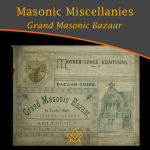 Masonic Miscellanies - Grand Masonic Bazaar (1895) Grand Masonic Bazaar (1895); to raise funds to clear the debt incurred by “Mother Kilwinning” in rebuilding their Lodge. |
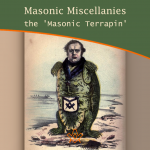 Masonic Miscellanies - the 'Masonic Terrapin' A satirical book from 1851 includes a bizarre caricature of a 'Masonic Terrapin' - all I can say is 'read on'… |
 Masonic Miscellanies - Masonic Bookplates You probably know what a bookplate is for, but did you know that the earliest known book mark/label dates from the reign of Amenhotep III in Egypt around 1391−1353 BCE?! |
 Masonic Miscellanies - Freemasonry & Bees Freemasonry & Bees - what's the buzz? The bee was among the Egyptians the symbol of an obedient people, because, says Horapollo, of all insects, the bee alone had a king. |
 Masonic Miscellanies - The mystery of the Tattooed Freemason In 1894, the body of a drowned man was found in the Bay of San Francisco - what they discovered was amazing. |
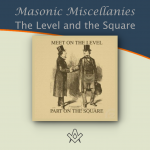 Masonic Miscellanies - The Level and the Square (A Poem) The Level and the Square (A Poem) - "We meet upon the Level, and we part upon the Square – |
 Masonic Miscellanies - The Mystic Tie What is the 'Mystic Tie'? Clue: it's not an item of neckwear! |
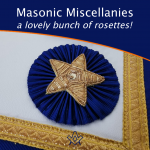 Masonic Miscellanies - A lovely bunch of rosettes! Where did the origin of the use of rosettes on Masonic aprons come from ? |
 Masonic Miscellanies - The Lodge of Sorrow The Lodge of Sorrow - Extracted General Ahiman Rezon, by Daniel Sickles, [1868] |
 Masonic Miscellanies - Memento Mori Memento Mori - a Masonic reminder to make your mark on the world |
 Masonic Miscellanies - A closer look at the Level and the Plumb-rule A closer look at the Level and the Plumb-rule |
 Masonic Miscellanies - The Symbolism of the Gloves The Symbolism of the Gloves and why Freemasons wear white gloves |
 Masonic Miscellanies - Will the real James Anderson please stand up? Will the real James Anderson please stand up? |
 Masonic Miscellanies - The Legend of the Third Degree The most important and significant of the legendary symbols of Freemasonry is, undoubtedly, that which relates to the fate of Hiram Abif. |
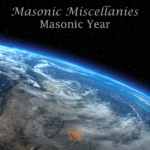 Masonic Miscellanies - Masonic Calendar Why do Freemasons use different 'years' to our regular calendar? |
 Masonic Miscellanies - What is a 'Lewis'? The English word 'Lewis' is a term belonging to operative Masonry, and signifies an iron cramp, which is inserted in a cavity prepared for the purpose in a large stone. |
 Masonic Miscellanies - From J.S.M. Ward Ever wondered why masons had to be 'free' or why we have a Tyler? |
masonic knowledge
to be a better citizen of the world
share the square with two brothers

click image to open email app on mobile device



